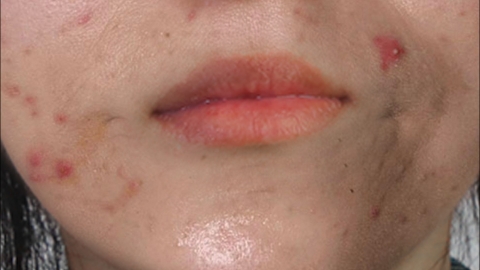How to get rid of cystic acne
Cystic acne is generally caused by factors such as excessive sebum production, abnormal keratinization of hair follicle openings, bacterial folliculitis, hormonal imbalances, and polycystic ovary syndrome. It is recommended to seek medical attention promptly, identify the underlying cause, and follow a doctor's guidance for improvement through general management, medication, and other treatments. Specific causes are analyzed as follows:

1. Excessive sebum production: During puberty or due to hormonal fluctuations, increased sebaceous gland activity can lead to oily skin that clogs pores and forms cysts, manifesting as oily skin and subcutaneous nodules. Cleanse the face twice daily with a gentle facial cleanser, avoid over-cleansing, and use lightweight, oil-controlling moisturizers.
2. Abnormal follicular keratinization: Disrupted turnover of the keratin layer at the follicular opening leads to clogged pores and trapped sebum, resulting in cyst formation—commonly seen on the forehead and chin. As directed by a physician, apply topical medications such as tretinoin cream, adapalene gel, or isotretinoin gel at night to promote normal exfoliation of dead skin cells.
3. Bacterial folliculitis: Infection of hair follicles by *Propionibacterium acnes* triggers inflammation, which may progress into cysts accompanied by redness, swelling, and pain. Patients should use antibiotics such as clindamycin gel, benzoyl peroxide gel, or doxycycline tablets under medical supervision to inhibit bacterial growth.
4. Hormonal imbalance: Lack of sleep and high stress levels can disrupt hormone balance, stimulating sebaceous glands and triggering recurrent cystic acne. When necessary, follow a doctor’s advice to take hormonal regulators such as spironolactone tablets, ethinylestradiol/cyproterone acetate tablets, or medroxyprogesterone acetate tablets.
5. Polycystic ovary syndrome (PCOS): In female patients, ovarian dysfunction leads to elevated androgen levels, causing cystic acne along with irregular menstruation. Treatment may include medications such as dydrogesterone tablets, progesterone capsules, or metformin tablets as prescribed to regulate endocrine function.
In daily life, maintain clean and dry skin, avoid touching or squeezing acne lesions to reduce the risk of infection. Eat plenty of fresh fruits and vegetables rich in vitamins, and avoid spicy or irritating foods. Comprehensive skincare practices can help resolve cystic acne and support overall skin health.





